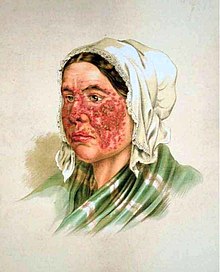History of dermatology
Among the first to take an interest in skin diseases were the Mesopotamian peoples, who sought to understand the reasons for these problems, often resorting to explanations rooted in religion, astrology and divination, and were the first to observe and define various dermatopathies.
[1][2] One of the most influential sources of understanding views on skin conditions in Mesopotamia comes from the Babylonian chief scholar Esagil-kin-aplim, who wrote a diagnostic manual called Sakikkū.
[2] While matching the descriptions of diseases in the few surviving cuneiform medical texts to specific ailments is challenging, it appears likely that Babylonians and Assyrians were the first to define and describe warts, pustules and scabies in writing.
Doctors of the era clearly sought to define disease according to certain criteria, using observations such as such as heat, smell, breath and bodily fluids, to help draw a diagnostic conclusion.
[6][7] Ancient Egyptians believed in a form of proto-humorism, that skin diseases were a symptom of health problems inside the body, caused by a blockage in the flow of bodily fluids.
[9] Greek medicine, with its focus on the harmony between external beauty and internal goodness, laid the foundation for dermatological practices, emphasizing a healthy diet and physical activity.
[12] Rome, while indebted to Greek medical knowledge, also absorbed insights from Etruscan magical medicine, which revered water's regenerative powers and utilized plants for their antiseptic properties.
[12] For example, the Benedictine monk Constantine the African assembled a vast collection of medical works, which he translated into Latin and used to inform his teaching at the Abbey of Monte Cassino, a major centre of learning in the 11th century.
Trota of Salerno introduced new practices for treating the skin inspired by eastern societies[16] and Rogerius first used the term lupus to describe the malar rash, [citation needed] with both physicians associated with the medical school.
[17] The Middle Ages in Europe saw a marked rise in infectious skin diseases, such as leprosy and plague, and the figures of surgeons and barbers (who, at the time, offered surgical interventions) emerging alongside physicians in the treatment of dermatological symptoms.
[18] While Mercuriali was a generalist physician, he went on to write many texts focused on skin diseases, as well as De Decoration Liber ("Book on Adornment") about the use of cosmetics, such as to hide blemishes.
He blamed humours for discolourations in the skin, and wrote on how pregnant women could inflict marks and deformities on their unborn children due to the "strong imagination or disappointed longings of the mother".
Physicians at the Charité, such as Gustav Simon and Felix von Bärensprung, led a department at the hospital that focused on the research into and treatment of skin diseases and syphilis.
[28][12] Medical scientists continued with experiments analysing the effectiveness of various forms of light, such as UVA and UVB radiation, and combining UV treatments with compounds such as psoralen (so-called PUVA therapy).


